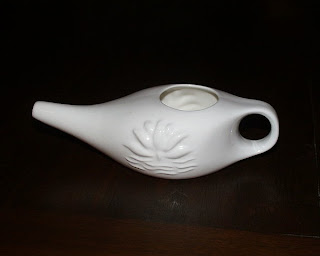 |
| Image Credit: Antonio Foncubierta. |
Last summer, when a friend told me about a brain-eating parasite that lurks in warm freshwater swimming areas and can kill you in just one week, I thought, “Hmm, interesting, but a bit obscure even by my standards.” A quick check with the CDC website confirmed that such infections were absurdly rare – only 32 were reported in the United States in the entire decade from 2001 to 2010 – and so the topic was shelved in favor of more newsworthy science. But now, with two people in Louisiana dead at the (figurative) hands of the grisly microbe, and the state issuing a warning about the perils of improper neti pot usage, Naegleria fowleri is suddenly looking more relevant.
The Louisiana cases are peculiar in that their victims didn’t have to dive into a warm lake or pond to encounter the parasite. Rather, it came to them, straight from the tap they used to fill a neti pot – a popular device for irrigating the sinuses.
How does this happen?
The microorganism responsible for all this trouble, Naegleria fowleri, is an amoeba that inhabits warm fresh water (a sustained 80˚F or above is its preferred aquatic climate). While content to live in water, it can also make its way into the human body via the mucosa in the nasal cavity, i.e., if you happen to get water up your nose. After gaining entry, it crawls along the olfactory nerves into the brain, where it chows down on vital central nervous system tissue. The ensuing illness is dubbed Primary amoebic meningoencephalitis (PAM).
The standard way to contract PAM is swimming in warm, amoeba-friendly waters (the microbe is found through the world, though is most common in warmer areas). Activities that increase the chance of water getting into your nose – such as diving or jumping – also up the risk of being infected by Naegleria fowleri.
 |
| Genie? No. Brain-eating amoebas? Maybe. Image: Kurt Yoder. |
The amoeba can live in lakes, rivers, ponds and hot springs. It occasionally even crops up in poorly maintained swimming pools. It isn’t considered common in tap water, which undergoes a purification process to render it potable. Yet apparently, Naegleria fowleri has turned up in Louisiana’s tap water at least twice this year* And the neti pot, which is used to pour water through the nostrils (with the head tilted sideways, not directly up the nose) provides an interaction with the tainted water similar to that experienced splashing around in lakes during the summer months.
Could it happen to me?
Counterintuitive though it may sound, tap water teeming with Naegleria fowleri is still safe to drink. That’s because the microbe needs to enter your nose rather than your mouth to cause PAM. And neti pots are okay too, just not for use with tap water. Additionally, the illness is not communicable from person to person and the amoeba doesn’t live in saltwater. Although pouring ocean water through your nose doesn’t sound like a great idea either.
With so many other pathogens out there, how seriously should you take this one? Well, as with many splashy media maladies – such as mad cow disease – PAM is scary not for its prevalence (extremely low) but rather for its prognosis (extremely grim). The disease is usually fatal, and rapidly so at that. Initially symptoms are similar to those of bacterial meningitis – headache, fever, nausea, stiff neck – but these will soon progress to confusion, loss of balance, hallucinations, seizures and the like. By the time these second wave symptoms set in, there has already been significant destruction to brain tissue. So, yeah, you want to avoid getting this infection in the first place.
Its rareness means that the odds are already on your side. You can improve your chances even more by using a nose plug when swimming underwater, and by sticking to distilled (or thoroughly boiled) water when loading up your neti pot.
* The first case occurred in June of 2011, the second in October. Caveat alert: the cases are still under investigation.
No comments:
Post a Comment